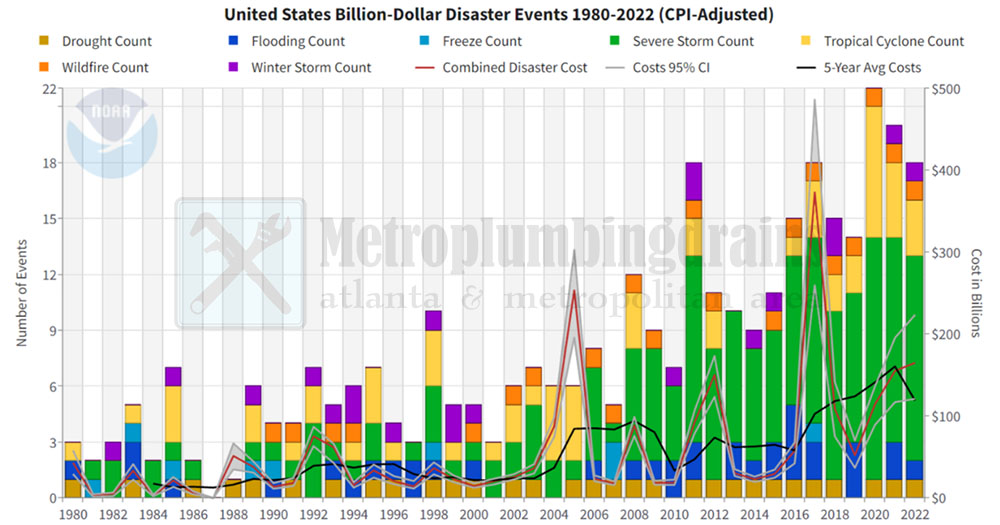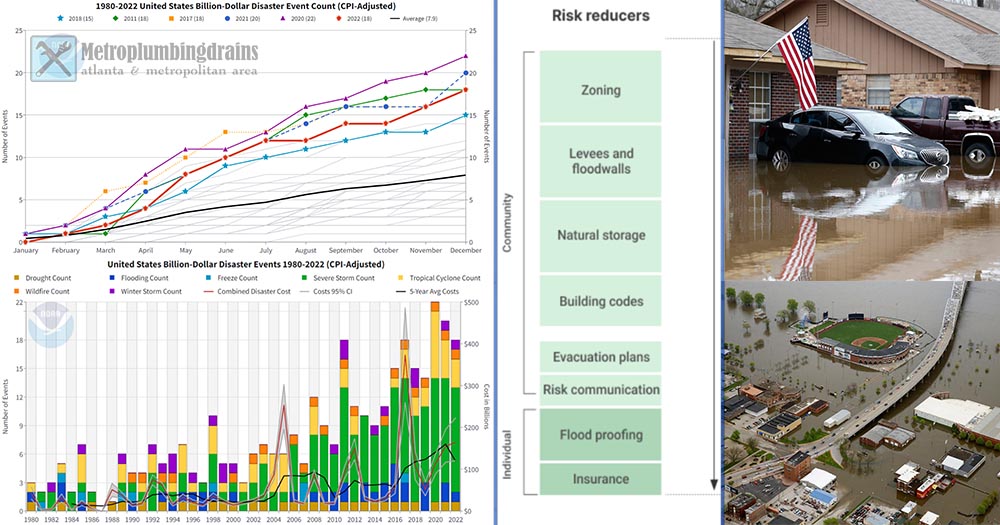Why do you need the phone number of a water restoration company near you?
The answer to the question: “Why should you have the phone number of a water restoration company near you?”, is contained in the following article. The frequency of floods in the United States and the damage they cause continue to increase each year. In 2022, the cost of structural damage to commercial real estate caused by flooding alone was nearly $14 billion. By mid-century, this amount is expected to increase to at least 25%. Flood damage to local economies is estimated at $50 billion by 2022. Approximately 730,000 retail, office and multi-unit residential properties face an annual risk of flood damage in the USA. Total damages from extreme weather caused by global warming in the US are estimated at nearly $165 billion (2022). At least 5,000 people have died and more than $1 trillion has been spent on damage. This is a result of 122 unique billion-dollar catastrophes over the last 7 years (2016-2022).
Global climate warming
Unfortunately, global climate warming is not a “hoax”. And it’s not a scary fairy tale that scientists spread to secure research funding or for some other reason hidden from us. The truth is catching up with us year after year, with increasingly catastrophic consequences for our businesses and for ourselves. Because water doesn’t pick – it sweeps everything in its path, whether you’re poor or rich, whether you’re a homeowner or a renter, whether you live in Florida and the nation’s Atlantic coast or along the Chattahoochee River, GA. The warming of the world’s oceans is melting our planet’s polar caps at a surprising rate. Life along the coast or along rivers, lakes, or reservoirs is now significantly more risky in terms of flooding. There has been a sharp rise in home flooding damage. Furthermore, flood damage is very costly. This type of disaster in the United States have cost at least $50 billion in damages during the last ten years.
U.S. Flood Projections to 2050
Here are some of the expected tendencies related to flooding in the coming years in the United States. The data are from the State of High Tide Flooding (HTF), 2022 Outlook and some other researches:
-
The frequency of flooding
Both from high tidal flooding (HTF) along the U.S. coasts and from water escaping from riverbeds and reservoirs inland, will continue to increase. This year, eastern U.S. communities will continue to experience an over 150% increase in HTF compared to the year 2000.
-
HTF (High Tide Flooding)
On a national level, HTF is predicted to occur on an average of 45 to 70 days per year by 2050. These long-term forecasts are based on data from the 2022 Sea Level Rise Technical Report and the range of anticipated relative sea level rise by 2050.
-
Sea levels
In some parts of the U.S., such as the Mid-Atlantic, sea levels are increasing more dramatically. If the land is collapsing and the water is rising, the risk is greatest. As people pump out drinking water, gas, and oil in Louisiana and Texas, the earth crumbles as a result of this exploitation.
4. Flooding during hurricanes (FDH)
FDH is also increased worse by rising seas. This is as a result of storms pushing more ocean water ashore. Also, since subterranean drainage lines are filled with salt water, precipitation accumulates and backs up in streets, parking lots, and basements.
Moreover, climate change is increasing the amount of rain that falls during storms, which can lead in flash floods.
What are the flood dangers for the state of Georgia till the middle of the century?
The state of Georgia is bordered to the east by the Atlantic ocean and to the southeast by the most flood-prone peninsula in the USA, the state of Florida. Georgia has 408,060 properties with a greater than 26% chance of experiencing massive flooding over the course of the next 30 years. This accounts for 11% of all Georgian properties (data from Riskfactor.com).
What measures could you take to reduce the damage from a massive flood?
In general, the decisions that are made at the national, state, and municipal levels in this direction are more effective than the measures that an individual or a family could take. But that doesn’t mean leaving yourself to the discretion of the authorities or fate. Strengthen your home better. Structural alternatives can help make a property more absorbent to minimize runoff and prevent flooding, help flood-proof a residence to reduce physical damage, or both.
Here are some low-cost flood solutions to reduce flood damage:
-
Rain barrels and cisterns
This is an effective drainage system, which is a ditch with a perforated pipe or gravel laid in it. Before you begin a french ditch drainage project, find out more about the local permitting procedure. To find out if a permission is required, contact the planning or zoning office in your area.
-
Rain garden (RG)
This is a type of green infrastructure used to reduce flooding caused by storm-water runoff. A rain garden is a garden that is situated in a low-lying region of the landscape and is intended to catch and temporarily store rainwater. Rain gardens lessen runoff from driveways, roadways, or roofs. A rain garden’s capacity for holding rainfall in gallons is determined by the size of the catchment area and the depth of the rain garden.
All these solutions are not expensive. They may not even seem particularly complicated, but they actually require serious professional knowledge of plumbing and drainage systems. That’s why we recommend that you contact a certified plumbing or water restoration company near you to complete your desired project.
“Readiness” is the keyword
Insure your property against flooding, especially if you live in a risky area. Strengthen your property further. Keep the phone number of the water restoration and plumbing company you choose close at hand.


